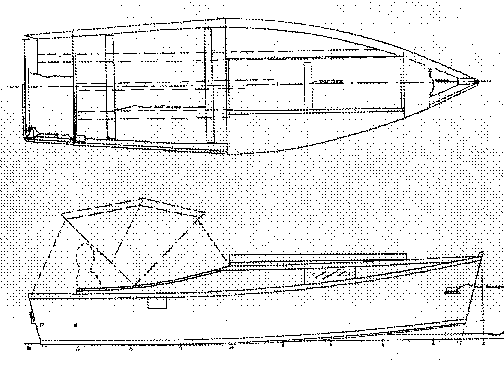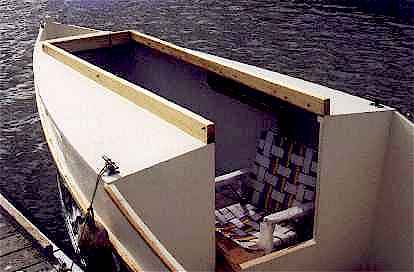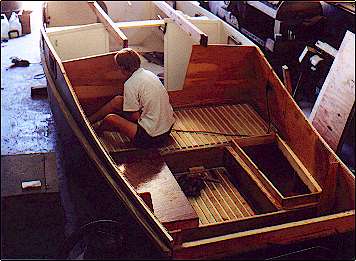
AF4 last summer.
Contents:
Contact info:
Jim Michalak
118 E Randall,
Lebanon, IL 62254Send $1 for info on 20 boats.
Jim Michalak's Boat Designs
118 E Randall, Lebanon, IL 62254
A page of boat designs and essays.
(15dec00) This issue talks about some testing we did with AF4 and a variety of old outboards. Next issue, 1jan01, will show a home made tiller/throttle extension.
READER GARY VANDERHART WRITES ABOUT NEW TECHNOLOGY AGM BATTERIES...
..."1. AGM batteries are sealed. They cannot spill acid, do not vent hydrogen gas, accept any installation orientation, and can be shipped by UPS. 2. AGM batteries can be completely discharged without damage or loss of capacity 100 to 400 times. This factor should make them last many times as long as a wet cell. 3. AGM batteries excel at high current charge/discharge and low current deep discharge simultaneously. 4. AGM batteries have low internal resistance. They can be stored over winter (or summer) without trickle charging or otherwise maintaining them with no loss of capacity. 5. AGM batteries work well with existing smart battery chargers.
1. AGM batteries will vent if severely overcharged. This is a disadvantage, but gel cells and flooded wet cells have this disadvantage as well. 2. AGM batteries cost 2 or 3 times the price of a wet cell. This is the only real disadvantage.
For side-by-side comparisons of flooded and AGM see www.geocities.com/CapeCanaveral/Lab/8679/battery.html"
|
|
Left:
AF4 last summer.
|
|
|
Messin' With Motors
THE ANTIQUE OUTBOARD MOTOR CLUB...
... in the St. Louis area has meetings a few times a year where folks bring old stuff they want to sell or get rid of. Right now the situation is that some motors are very collectable so they are searched out and restored and cherished or sold to someone who will cherish them. Those might be very rare and a common boater might have no real interest in them.
I've noticed there are other levels of old motors that make a motor user, like me, interested in attending a meeting. I've been told that more outboard motors were built in 1956 than before or since. Back then the largest motor available was about 40 hp, and most were a lot smaller, portable and suitable for smaller fishing boats. Lots of those motors are still around and in pretty good shape. The AOMC folks aren't all that interested in them because they are common, but they still pick them up and resell them. They can usually tell you about getting parts for them. Since they aren't considered collectables they don't cost an awful lot. So you might get an old but good 5 to 20 hp Johnson for less than $200.
There seems to be another class of motor, off brand aircooled Clintons and Tecumsehs that were sold by Sears and Montgomery Wards, that goes really cheap - maybe free to $50.
These aren't modern motors. They don't come with manuals and you will have to figure out how to start and operate and tinker with the motors. They are seldom worn out. They are usually messy. But they give us cheap folks an option for small boats.
Anyway, Max from St. Louis came over to Carlyle Lake with a truck full of old motors and we tested them on my AF4.
(Here is a photo of Max at our last messabout beside his boat. The motor is an early 40's 22 hp Johnson. No doubt Max is contemplating starting it, where the boater spends about five minutes wooing and courting the motor, climaxing with wrapping a cord around the flywheel and giving a mighty pull (sometimes over and over again). When she starts with a pounding throb your concerns have only started for the motor is direct drive and 22 hp will will push that little boat very quickly. You had better be pointed in the right direction. The motor is water cooled but there is no pump - it works on head pressure from forward motion so you can't idle long either. Outboarders were hearty men back then, not like the button pushing wimps of today.)

THE MOTOR TESTS...
... were run in good summer weather over a fairly protected course. Weather and waves were not a factor. We found an inlet with a buoy on one end and a trot line stake at the other end. I ran the AF4 with my Johnson 10 between the marks at full throttle at the start of the day and it covered the distance in 107 seconds. Since I had measured the speed with this motor several times over other courses at 17 mph, it works out that the two marks were .50 miles apart. I used that as a standard for all the other tests, although someday it would be nice to repeat with a GPS unit for better accuracy.
All motors were given at least 5 minutes warmup and the runs were all made at full throttle. Two runs were made with each, one in each direction, the times added together to give a run over a full mile which would hopefully adjust for any winds or waves.
I guessed at the weight during each run. My empty AF4 weighs about 300 pounds and I weigh about 170 pounds. Max was on board for some of the runs and he thought he weighed about 230 pounds due to his heavy boots and clothing. The 1956 Johnson 10 weighs about 70 pounds and its fuel tank about 30 pounds (with about 4 gallons of fuel).
TEST 1, A SEARS 5...
... with a Tecumseh air cooled power head. About 1970 vintage with little sign of use. Everything and everybody on board, about 850 pounds all up. Max walked forward in the boat during the test and it sped up a lot liking its bow down and transom up. It covered the mile in 9:10 for 6.5 mph. Not on plane.
TEST 2, the SEARS 5...
... only this time Max stayed on shore so the rig weighed about 620 pounds. Time over the mile was 9:20 for 6.4 mph. Slower than the first run! Max's forward trim weight had paid for itself and then some.
TEST 3, A JOHNSON 7.5...
...from 1953. Weight about 570 pounds now since the Johnson 10 had been removed at this point. Max had told me that this motor had quirks in its gaskets that could cause cooling problems. Sure enough about 1/3 way through the mile she seized and I rowed to shore, so no results for this motor. I'm told the motor freed up later.
TEST 4, A JOHNSON 5.5...
... from 1959. Weight about 550 pounds. Made the mile in 7:31 for 8 mph. Max told me this motor was probably the most worn of any we were testing.
TEST 5, A JOHNSON 18...
...from 1957. Weight about 590 pounds. Made the mile in 2:45 for 22 mph. Might have been a bit faster but I was distracted by its strength and acceleration, fumbling with my watch, pencil and paper as it set me back in the seat. I'm not used to going that fast and really had to pay attention.
WE MADE SEVERAL OTHER TESTS...
...with different props on different motors, none of which were improvements over the first runs. Max keeps a large box of props in his truck just in case.
I came back a few days later with the Sears 5 because the runs with Max providing bow down trim made me curious. This time I did not take the Johnson 10 with me so the all up weight was about 560 pounds. More important the 100 pounds of Johnson and fuel was no longer on the stern, as we had found that trim was as important as weight, at least in the low power range. This time the AF4 covered the mile in 8:20 for 7.2 mph.
I slipped a 4' pipe over the tiller of the Sears 5 which would allow me to sit right up by the cabin bulkhead, trimming the boat well down at the bow. She now covered the mile in 7:40 for 7.8 mph.
I repeated the same mile run with the tiller extension at half throttle, easily done with this motor since it has a sliding throttle instead of a twist grip. Covered the mile in 9:30 for 6.3 mph.
Also ran my old Sea King 3.5, an air cooled Clinton sold by Mongomery Wards in 1970, over the mile with the tiller extension. It covered it in 9:24 for 6.4 mph. At half throttle it went 5.9 mph. Weight about the same as above, say 560 pounds.
Finally I ran the course with a Sears 7.5, again air cooled of about 1970 vintage. At full throttle it ran the mile at 10 mph, on plane. Weight about the same again since these air cooled motors all weigh about the same.
TO SUM IT UP...
Pulling out the mandatory graph...

WHAT DOES IT MEAN???...
One observation is that at about 7 or 8 mph the bow of AF4 starts to lift a few degrees and I suppose it has met the "hump" that comes before planing. By about 10 mph it is on full plane. Above about 15 mph the bow starts to come down again and at 22 mph with the Johnson 18 the boat was about as level as at pure displacement speed, although it is skimming over the water at that speed.
Remember that Dave Gerr's information above is a very "standard" thing for an "average" boat. The smaller motors tend to not go as fast as the chart would predict if you use the rated powers of those air cooled motors. My own feeling is that these motors put out about 2/3 of the rated power, not because they are weak or worn, but more because of the way the vendors lied about their power. For example, I have the original literature that came with the Sea King 3.5. It states very clearly that full throttle operating range is 4000-5000 rpm, but the peak hp is reached at 6800 rpm at 60 degrees F. If the Sea King operates at 4500 rpm full throttle as installed on the boat, but peaks at 3.5hp at 6800 rpm on a dyno, then it would to me be reasonable to think that at 4500 rpm the real output is around 4500/6800 x 3.5 = 2.3 hp. If true, then that run is really made at 240 lbs/hp instead of 160 lbs/hp, and then Gerr's graph would predict 6.6 knots. That still doesn't bring it up to Gerr's line and it is quite possible that the wide deep power boat stern simply isn't going to keep up with a better displacement hull shape in the low power tests. But a good displacement hull shape has little or no chance of being driven past displacement speeds under control.
Another factor to consider is that new motors have their power measured at the prop and the older ones were measured with the power head removed from the drive section, as was the 3.5 hp Clinton. Max said the drive train typically absorbs about 10% of the power.
The 10 hp speed falls right on Gerr's line and the boat is fully on plane by then. 10 horse motors are famous for being under rated, that is many put out more than 10 hp. The idea is that "my 10 horse is faster than your 10 horse" is a big plus for the ad makers. Max told me once that the Mercury 10's of the 1950's had more cubic inches than the Johnson 15. I think I once figured my Johnson 10 is putting out about 11 hp to totally agree with Gerr's chart.
I think I could come up with a lot of reasons why the performance fell below the ideal but what sort of surprises me the most is how smooth the measured curve is. And if someone were to hand me an ordinary old motor between 3 and 20 hp I could use the chart to quicky estimate my AF4's top speed with that motor. Maybe someday I'll get to run these tests with new motors.
NEXT TIME...
Will show the tiller/throttle extension I brewed up based on the above tests.
AF4

AF4, CUDDY POWER SKIFF, 18' X 5', 350 POUNDS EMPTY
AF4 is a simple low powered cuddy cruiser intended for protected waters. Kilburn Adams of St. Louis brought a boat similar in spirit to AF4 to our Midwest Messabouts and it was easy to see what a good idea this is. Kiburn's boat was a modified Sturdee Amesbury power dory with a small cuddy added and a new 4 stroke Yamaha 10. He thought the empty boat weighed about 600 pounds ready to go. It planed quite well with two men on board at about 13 knots. He made a 60 mile trip on the Mississippi (above the Alton dam where the current is small) burning about 4 gallons of fuel. It's quiet and cheap to operate. It's a good idea now that smaller 4 stroke motors are more common.
Here is an AF4 by Barry Targan. I think he is using a new 8 hp 4 cycle.

AF4 is supposed to do about the same job. Its simple hull shape won't handle rough going like the dory, but it's very easy to build and roomier. This boat has an open bow well for anchors and junk. The cabin is 8' long and 3' deep and 4' wide for minimal camping. It should be comfy for one and snug for two. it has a slot top to allow stand up boating in good weather. You cover it with a snap on fabric piece in the rain and cold. The cockpit is a full 6' long and 4' wide and totally open. You could lounge there too with a folding chaise. Aft of the cockpit is a draining motor well which will take the standard 6 gallon fuel tank and then some.

For power Iwould say 10 horsepower maximum. AF4 planes easily with an old Sears 7-1/2 horse (single cylinder, air cooled, for $50 at a yard sale) as you can see here:

AF4 uses the simplest nail and glue construction. It takes five sheets of 1/4" plywood and four sheets of 1/2" plywood.
There is also a shorter 15' version called AF4Breve, the prototype shown here built by Bruce Given.

Plans for either AF4 or AF4Breve are $30.
Prototype News
Some of you may know that in addition to the one buck catalog which now contains 20 "done" boats, I offer another catalog of 20 unbuilt prototypes. The buck catalog has on its last page a list and brief description of the boats currently in the Catalog of Prototypes. That catalog also contains some articles that I wrote for Messing About In Boats and Boatbuilder magazines. The Catalog of Prototypes costs $3. The both together amount to 50 pages for $4, an offer you may have seen in Woodenboat ads. Payment must be in US funds. The banks here won't accept anything else. (I've got a little stash of foreign currency that I can admire but not spend.) I'm way too small for credit cards.
Here are the prototypes abuilding that I know of:
Caprice: A brave and experienced builder in Texas is making the 25' Caprice water ballasted sailboat. A big project.Here the builder plugs away at the aft deck.

Jon Jr has been completed by Joe Leinweber and Dan Ellis and tested to a certain degree. Click here to read about the test and the surprize ending! ("The waters are only safe until next time!")

Mayfly12: A Mayfly12 is now completed and has been sailed. Waiting for final photos but here is an initial photo.

AN INDEX OF PAST ISSUES
Herb builds AF3 (archived copy)
Hullforms Download (archived copy)
Plyboats Demo Download (archived copy)